#gershon legman
Photo

Bruce Abbott - The Sign Of The Scorpion - Grove Press - 1970
#witches#scorpions#occult#vintage#grove press#sign of the scorpion#1970#bruce abbott#noel quarter#Wood C. Lamont#robert sewall#gershon legman#devil's advocate
274 notes
·
View notes
Text


The guy does not hold back! This is 1949, mind you.
10 notes
·
View notes
Text
“Legman argued that sex wasn’t pornographic but violence was. In a nutshell: make love, not war—a phrase he later claimed he coined in a 1963 speech."
4 notes
·
View notes
Photo


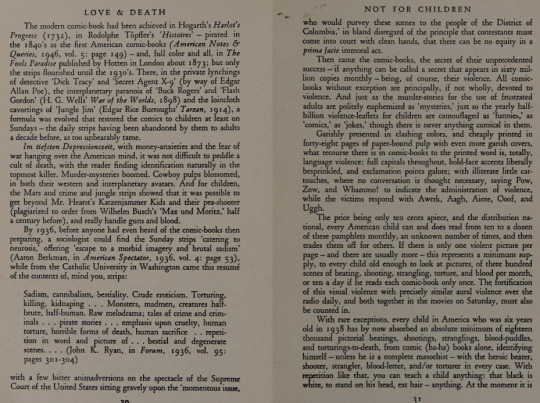
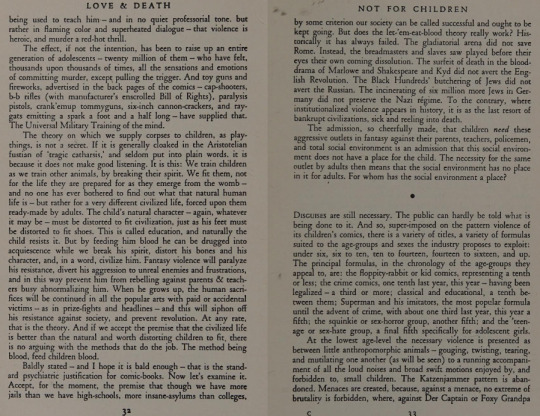
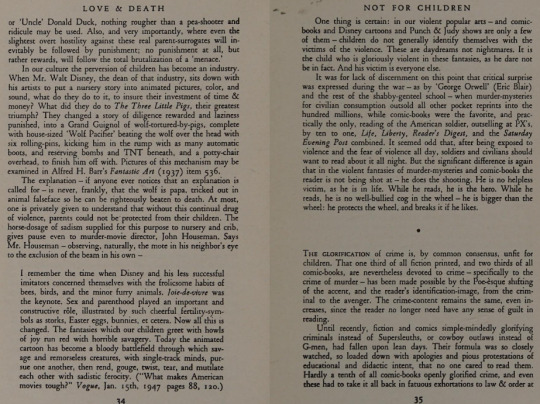
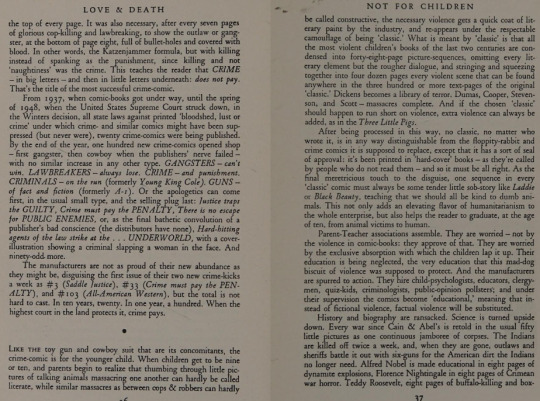
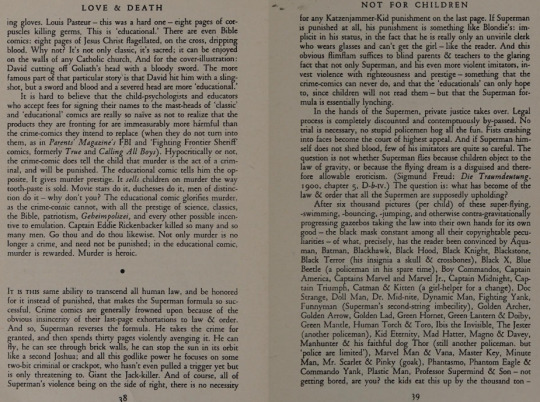

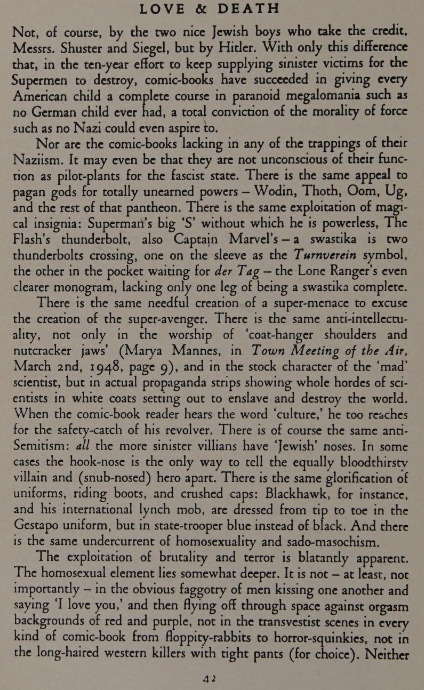

The aggressive content of comic books is so conspicuous that most observers fail to notice that this aggression is rigidly channelized, that the willingness of any reader to accept a fantasy escape from his frustrations presupposes a willingness to achieve less than total and actual escape. Like all other forms of dreaming, literature operates under a censorship. And this censorship -- in both its legal and internalized expression -- does not allow any direct, total attack on the frustration that elicits the dream. It offers a choice.
- Love and Death: A Study in Censorship (1949), Gershon Legman
Five years before Fredric Wertham’s infamous Seduction of the Innocent essay and the subsequent spark of anti-comic sentiment that nearly killed the industry along with the introduction of the Comics Code Authority and the Senate Subcommittee Hearing into Juvenile Delinquency, Gershon Legman had explored similarly sentiments in Love and Death: A Study in Censorship (1949).
The belief that the violence of pre-code comics was harmful to children and the approach of the ‘Superman model’ as inherently fascist explored in Legman’s work would form much of the basis for Wertham’s later criticism and the crusade against comics. Interestingly enough, Gershon Legman is widely believe to have been gay himself.
#love and death#love and death 1949#love and death: a study in censorship#gershon legman#fredric wertham#seduction of the innocent#anti-comics sentiment#anti comics sentiment#comics censorship#comic book history#u can reblog#i thought this was immensely interesting and obvious nonsense aside i think it brings up much better points than wertham's nonsense#primarily because legman is legitimately concerned w the portrayal of villains are racialized caricatures in some way or another#vs the white conventionally attractive socially acceptable hero by default#and thats a very interesting sentiment for 1949#equally interesting is the wording in regards to what exactly this portrayed mindless violence is supposed to do and i would agree w it#to the extent regarding. say. present day military propaganda in superhero movies#theres a lot to be said about it but id say its wildly interesting#and then extremely funny when it implies all aac and dc employes were gay. hell i wish#the end is obviously nonsense but i think it does read differently coming from a gay man#thoughts anybody?
15 notes
·
View notes
Text
My day job isn't usually terribly exciting, but sometimes I do get emails alerting me to the fact that someone has released a previously-thought-lost collection of erotic sea shanties. Enjoy, ye salty seamen!
#age of sail#cabin boys milkmaids and rough seas#stan hugill#sea shanty#sea songs#sea shanties#19th century#20th century#maritime history#nautical history#naval history#music history#pirates#piratecore#maritime#nautical
73 notes
·
View notes
Photo

I remember quite well how Gershon Legman described that in the taxonomy of folktales, the category meant for sexual humour was empty. Since visiting the Mundaneum in Mons, I have been re-investigating classification and taxonomy and decided to look up where erotica and pornography are to be found under the MDS (Melville decimal system) and the UDC (Otlet's Universal Decimal System).
At the Dewey, you will find under 82-7 "Prose satire. Humour, epigram, parody". That same number houses “satire and humor” at the UDC. But I decided to search a little further and found at a document entitled Dewey decimal classification and relative index (1979) that erotica is listed under number 704.9428.
And at the UDC you will find 82-993: "Licentious, salacious, titillating literature. Erotica. Pornography". By the way but still very much on topic on a personal level, the neighboring category 82-994 houses "offbeat , eccentric literature . Inspirational , visionary , insane literature" and next door you find 82-995: "Literary fabrications , hoaxes. Pastiches . Imaginary , supposed works ." Beautiful, not?
Illustration: Erotica is 704.9428 in the Dewey decimal system.
4 notes
·
View notes
Text
Birthdays 11.2
Beer Birthdays
Theodore Hollencamp (1834)
Louis C. Huck (1842)
Anton Simon (1848)
Franklin Pierce Lauer (1852)
David Oldenburg
Tyler Brown (1967)
Joel Johnson (1969)
Mariah Calagione (1970)
Ben Johnson (1977)
Five Favorite Birthdays
Bunny Berigan; jazz trumpeter (1908)
Daniel Boone; explorer (1734)
Steve Ditko; comic book artist (1927)
Keith Emerson; rock keyboardist (1944)
Burt Lancaster; actor (1915)
Famous Birthdays
Marie Antoinette; Austrian/French royalty (1755)
Rose Bird; Chief Justice, California Supreme Court (1936)
Jay Black; rock singer (1938)
George Boole; mathematician (1734)
Dale Brown; writer (1956)
Pat Buchanan; right-wing nut job (1938)
Carlos Bulosan; writer (1911)
Jean-Baptiste-Simeon Chardin; French artist (1699)
Cookie Monster; Muppet (1966)
Odysseas Elytis; Greek poet (1911)
Warren G. Harding; 29th U.S. President (1865)
k.d. lang; Canadian pop singer (1961)
Gershon Legman; sexologist (1917)
Maxine Nightingale; singer (1952)
James K. Polk; 11th U.S. President (1795)
Stephanie Powers; actor (1942)
Raphael M. Robinson; mathematician, philosopher (1911)
Ann Rutherford; actor (1917)
David Schwimmer; actor (1966)
Avy Scott; porn actor (1981)
Richard Serra; sculptor (1939)
Harlow Shapley; astronomer (1885)
Queen Sofía of Spain (1938)
J.D. Souther; singer, songwriter (1945)
Julia Stegner; German model (1984)
Luchino Visconti; Italian film director (1906)
Ray Walston; actor (1914)
Conrad Weiser; Pennsylvania Native American ambassador (1696)
Phil Woods; saxophonist, composer, bandleader (1931)
0 notes
Photo

trying to see the books on will’s bookshelf. these are visible in episode 1.04. i’m putting my guesses as to the authors,
no man’s land
introduction to logic
black sun - by edward abbey? it’s about a man named will living alone in the woods....
inner companions - by colman mccarthy?
moral clarity
the limerick - by gershon legman? collection of crass and dirty poetry lol
oscar wilde
jung
a new today (??)
the killing ??
the manhunters - i’m guessing it’s this by peter deeley
crime and punishment in american history - by lawrence friedman
i can’t read this one but forgot to cut it out of the image haha
a time to die
south wind - by norman douglas. here for free, if you’d like to read it.
sister carrie by theodore dreiser
shakespeare
36 notes
·
View notes
Note
Mom...
que me dirias si queme una iglesia :"V?

no metas mas leña ala fogata mija no debes tener esos pensamientos primitivos

debemos cambiar hagan el amor no la guerra dicho por Gershon Legman
20 notes
·
View notes
Text
Early Gay Male Terminology in New York
Selection from Gay New York: Gender, Urban Culture, and the Making of the Gay Male World, 1890-1940, by George Chauncey, 1994
This book argues that in important respects the hetero-homosexual binarism, the sexual regime now hegemonic in American culture, is a stunningly recent creation. Particularly in working-class culture, homosexual behavior per se became the primary basis for the labeling and self-identification of men as "queer" only around the middle of the twentieth century; before then, most men were so labeled only if they displayed a much broader inversion of their ascribed gender status by assuming the sexual and other cultural roles ascribed to women. The abnormality (or "queerness") of the "fairy," that is, was defined as much by his "womanlike" character or "effeminacy" as his solicitation of male sexual partners; the "man" who responded to his solicitations--no matter how often--was not considered abnormal, a "homosexual," so long as he abided by masculine gender conventions. Indeed, the centrality of effeminacy to the representation of the "fairy" allowed many conventionally masculine men, especially unmarried men living in sex-segregated immigrant communities, to engage in extensive sexual activity with other men without risking stigmatization and the loss of their status as "normal men."
Only in the 1930s, 1940s, and 1950s did the now-conventional division of men into "homosexuals" and "heterosexuals," based on the sex of their sexual partners, replace the division of men into "fairies" and "normal men" on the basis of their imaginary gender status as the hegemonic way of understanding sexuality. Moreover, the transition from one sexual regime to the next was an uneven process, marked by significant class and ethnic differences. Multiple systems of sexual classification coexisted throughout the period in New York's divergent neighborhood cultures: men socialized into different class and ethnic systems of gender, family life, and sexual mores tended to understand and organize their homosexual practices in different ways. Most significantly, exclusive heterosexuality became a precondition for a man's identification as "normal" in middle-class culture at least two generations before it did so in much of Euro-American and African-American working-class culture.
One way to introduce the differences between the conceptual schemas by which male sexual relations and identities were organized in the first and second halves of the twentieth century (as well as this book's use of terminology) is to review the changes in the vernacular terms used for homosexually active men, and, in particular, the way in which gay came to mean "homosexual". This does not mean reconstructing a lineage of static meanings--simply noting, for instance, that gay meant "prostitute" before it meant "homosexual." In keeping with the methodology of the study as a whole, it means instead reconstructing how men used the different terms tactically in diverse cultural settings to position themselves and negotiate their relations with other men, gay and straight alike.
Although many individuals at any given time, as one might expect, used the available terms interchangeably and imprecisely, the broad contours of lexical evolution reveal much about the changes in the organization of male sexual practices and identities. For many of the terms used in the early twentieth century were not synonymous with homosexual or heterosexual, but represent a different conceptual mapping of male sexual practices, predicated on assumptions about the character of men engaging in those practices that are no longer widely shared or credible. Queer, fairy, trade, gay, and other terms each had a specific connotation and signified specific subjectivities, and the ascendancy of gay as the preeminent term (for gay men among gay men) in the 1940s reflected a major reconceptualization of homosexual behavior and of "homosexuals" and "heterosexuals." Demonstrating that such terms signified distinct social categories not equivalent to "homosexual” and that men used many of them for themselves will also explain why I have employed them throughout this study, even though some of them now have pejorative connotations that may initially cause the reader to recoil.
Gay emerged as a coded homosexual term and as a widely known term for homosexuals in the context of the complex relationship between men known as "fairies" and those known as "queers." According to Gershon Legman, who published a lexicon of homosexual argot in 1941, fairy (as a noun) and queer (as an adjective) were the terms most commonly used by "queer" and "normal" people alike to refer to "homosexuals" before World War II.[26] Regulatory agents--police, doctors, and private investigators alike--generally used technical terms such as invert, pervert, degenerate, or, less commonly, homosexual (or homosexualist, or simply homo), but they also knew and frequently used the vernacular fairy as well. In 1917, for instance, an agent of an anti-vice society reported to his supervisor on a "crowd of homosexualists, commonly known as 'fairies.’”[27] Another agent of the society reported ten years later that he had noticed a "colored pervert" in a subway washroom, but added that in identifying the "pervert" to another man in the washroom he had used the more commonplace term: "I said, 'He is a fairy.’”[28]
While most gay men would have understood most of the terms in use for homosexual matters, some terms were more likely to be used in certain social milieus than others. Fag was widely used in the 1930s, but almost exclusively by "normals" (the usual word then for those who were not queers); gay men used the word faggot instead, but it was used more commonly by blacks than whites. An investigator who visited a "woman's party" at a 137th Street tenement in Harlem in 1928, for instance, reported that one of the women there told him '''Everybody here is either a bull dagger [lesbian] or faggot.’”[29] The investigator, a black man working for an anti-vice society, appears to have believed that the term was less well known than fairy to the "normal" white population. When he mentioned in another report that two men at a Harlem restaurant were "said to be 'noted faggots,'"[30] he quickly explained to his white supervisor this meant they were "fairies.” While gay white men also used the term faggot (although less often than blacks), they rarely referred to themselves as being “in the life," a phrase commonly used by black men and women.
Most of the vernacular terms used by "normal" observers for fairies, such as she-man, nance, and sissy, as well as fairy itself, emphasized the centrality of effeminacy to their character. In the 1920s and 1930s especially, such men were also often called pansies, and the names of other flowers such as daisy and buttercup were applied so commonly to gay men that they were sometimes simply called "horticultural lads." ("Ship me home," said a “nance” to a florist in a joke told in 1932. "I’m a pansy.")[32] The flamboyant style adopted by "flaming faggots" or "fairies," as well as its consistency with outsiders' stereotypes, made them highly visible figures on the streets of New York and the predominant image of all queers in the straight mind.
Not all homosexual men in the prewar era thought of themselves as "flaming faggots," though. While the terms queer, fairy, and faggot were often used interchangeably by outside observers (and sometimes even by the men they observed), each term also had a more precise meaning among gay men that could be invoked to distinguish its object from other homosexually active men. By the 1910s and 1920s, the men who identified themselves as part of a distinct category of men primarily on the basis of their homosexual interest rather than their womanlike gender status usually called themselves queer. Essentially synonymous with "homosexual," queer presupposed the statistical normalcy--and normative character--of men's sexual interest in women; tellingly, queers referred to their counterparts as "normal men" (or "straight men") rather than as "heterosexuals." But queer did not presume that the men it denoted were effeminate, for many queers were repelled by the style of the fairy and his loss of manly status, and almost all were careful to distinguish themselves from such men. They might use queer to refer to any man who was not "normal," but they usually applied terms such as fairy, faggot, and queen only to those men who dressed or behaved in what they considered to be a flamboyantly effeminate manner. They were so careful to draw such distinctions in part because the dominant culture failed to do so.[33]
Many fairies and queers socialized into the dominant prewar homosexual culture considered the ideal sexual partner to be "trade," a "real man," that is, ideally a sailor, a soldier, or some other embodiment of the aggressive masculine ideal, who was neither homosexually interested nor effeminately gendered himself but who would accept the sexual advances of a queer. While some gay men used the term trade to refer only to men who insisted on payment for a sexual encounter, others applied it more broadly to any "normal" man who accepted a queer's sexual advances. The centrality of effeminacy to the definition of the fairy in the dominant culture enabled trade to have sex with both the queers and fairies without risking being labeled queer themselves, so long as they maintained a masculine demeanor and sexual role. Just as significantly, even those queers who had little interest in trade recognized that trade constituted a widely admired ideal type in the subculture and accepted the premise that trade were the "normal men" they claimed to be.
Ultimately men who detested the word fairy and the social category it signified were the ones to embrace gay as an alternative label for themselves. But they did not initiate its usage in gay culture. The complexity of the emergence of the term's homosexual meanings is illustrated by a story told by a gay hairdresser, Dick Addison, about an incident in 1937 when he was a fourteen-year-old "flaming faggot" in a Jewish working-class section of New York:
“A group of us hung out at a park in the Bronx where older boys would come and pick us up. One boy who'd been hanging out with us for a while came back once, crying, saying the boy he'd left with wanted him to suck his thing. "I don't want to do that!" he cried. "But why are you hanging out with us if you aren't gay?" we asked him. "Oh, I'm gay," he exclaimed, throwing his hands in the air like an hysterical queen, "but I don't want to do that." This boy liked the gay life-the clothes, the way people talked and walked and held themselves--but, if you can believe it, he didn't realize there was more to being gay than that!”[34]
Gay, as the story indicates, was a code word. Gay men could use it to identify themselves to other gays without revealing their identity to those not in the wise, for not everyone---certainly not the boy in this story (unless he was simply using the word's protean character to joke with the group)--knew that it implied a specifically sexual preference. But it did not simply mean "homosexual," either. For all the boys, the "gay life" referred as well to the flamboyance in dress and speech associated with the fairies. Indeed, it was the fairies (the especially flamboyant gay men), such as the ones Addison associated with, who used the word most in the 1920s and 1930s. Will Finch, a social worker who began to identify himself as "queer" while in New York in the early 1930s, recalled in 1951 that the word gay "originated with the flaming faggots as a 'camp' word, used to apply to absolutely everything in any way pleasant or desirable (not as 'homosexual'), ... [and only began] to mean 'homosexual' later on.”[35]
The earliest such uses of gay are unknown, but the "flaming faggots" Finch remembered doubtless used the word because of the host of apposite connotations it had acquired over the years. Originally referring simply to things pleasurable, by the seventeenth century gay had come to refer more specifically to a life of immoral pleasures and dissipation (and by the nineteenth century to prostitution, when applied to women), a meaning that the "faggots" could easily have drawn on to refer to the homosexual life. Gay also referred to something brightly colored or someone showily dressed--and thus could easily be used to describe the flamboyant costumes adopted by many fairies, as well as things at once brilliant and specious, the epitome of camp.[36] One can hear these meanings echo through the decades in Finch's comment in 1963 that he still "associate[d] the word with the hand waving, limp-wristed faggot, squealing 'Oh, it's gay!'”[37] One hears them as well in the dialogue in several novels written in the late 1920s and early 1930s by gay men with a camp sensibility and an intimate knowledge of the homosexual scene. "I say," said Osbert to Harold in The Young and Evil, perhaps the campiest novel of all, "you look positively gay in the new clothes. Oh, said Harold, you're lovely too, dear, and gave him a big kiss on the forehead, much to Osbert's dismay.”[38] A chorus boy gushed to his friend in another, rather more overwritten 1934 novel, "I'm lush. I'm gay. I'm wicked. I'm everything that flames."[39] And Cary Grant's famous line in the 1938 film Bringing Up Baby played on several of these meanings: he leapt into the air, flounced his arms, and shrieked "I just went gay all of a sudden," not bceause he had fallen in love with a man, but because he was asked why he had put on a woman's nightgown. The possibility of a more precisely sexual meaning would not have been lost on anyone familiar with fairy stereotypes.
The word's use by the "flaming faggots" (or "fairies"), the most prominent figures in homosexual society, led to its adoption as a code word by "queers" who rejected the effeminacy and overtness of the fairy but nonetheless identified themselves as homosexual. Because the word's use in gay environments had given it homosexual associations that were unknown to people not involved in the gay world, more circumspect gay men could use it to identify themselves secretly to each other in a straight setting. A properly intoned reference or two to a "gay bar" or to "having a gay time" served to alert the listener familiar with homosexual culture. As one gay writer explained in 1941,
“Supposing one met a stranger on a train from Boston to New York and wanted to find out whether he was "wise" or even homosexual. One might ask: "Are there any gay spots in Boston?" And by slight accent put on the word "gay" the stranger, if wise, would understand that homosexual resorts were meant. The uninitiated stranger would never suspect, inasmuch as "gay" is also a perfectly normal and natural word to apply to places where one has a good time. ... The continued use of such double entendre terms will make it obvious to the initiated that he is speaking with another person acquainted with the homosexual argot.”[41]
Will Finch provided a similar example in 1946, when he described how a young man tried to determine whether Finch's friend Edward, whom he had just met, was also homosexual. The youth, obviously very interested in Edward, "acts all right," Finch reported, by which he meant the youth did not act like a fairy and make it clear he was homosexual by camping, "but throws in a few words like 'gay' for Edward to follow the lead on, but Edward plays dumb."[42] And in the early 1930s a speakeasy on East Twenty-eighth Street seeking gay patronage noted suggestively that it was located "in the Gay 20's." Similarly, in 1951 the Cyrano Restaurant let gay men know they were welcome while revealing nothing to others by advertising itself as the place "Where the Gay Set Meet for Dinner."[43]
While such men spoke of "gay bars" more than of "gay people" in the 1920s and 1930s, the late 1930s and especially World War II marked a turning point in its usage and in their culture. Before the war, many men had been content to call themselves "queer" because they regarded themselves as self-evidently different from the men they usually called "normal." Some of them were unhappy with this state of affairs, but others saw themselves as "special"--more sophisticated, more knowing--and took pleasure in being different from the mass. The term gay began to catch on in the 1930s, and its primacy was consolidated during the war. By the late 1940s, younger gay men were chastising older men who still used queer, which the younger men now regarded as demeaning. As Will Finch, who came out into the gay world of limes Square in the 1930s, noted in his diary in 1951, "The word 'queer' is becoming [or coming to be regarded as] more and more derogatory and [is] less and less used by hustlers and trade and the homosexual, especially the younger ones, and the term 'gay' [is] taking its place. I loathe the word, and stick to 'queer,' but am constantly being reproved, especially in so denominating myself.”[44]
Younger men rejected queer as a pejorative name that others had given them, which highlighted their difference from other men. Even though many "queers" had also rejected the effeminacy of the fairies, younger men were well aware that in the eyes of straight men their "queerness" hinged on their supposed gender deviance. In the 1930s and 1940s, a series of press campaigns claiming that murderous "sex deviates" threatened the nation's women and children gave "queerness" an even more sinister and undesirable set of connotations. In calling themselves gay, a new generation of men insisted on the right to name themselves, to claim their status as men, and to reject the "effeminate" styles of the older generation. Some men, especially older ones like Finch, continued to prefer queer to gay, in part because of gay's initial association with the fairies. Younger men found it easier to forget the origins of gay in the campy banter of the very queens whom they wished to reject.
193 notes
·
View notes
Text
"Regardless of his own (not insubstantial) writing, his greatest poem was one on which he was at best a cowriter—Roth v. United States, the 1957 Supreme Court case that would begin to redefine “obscenity.”"
0 notes
Note
Do you really believe alan was intended to be gay all along?
yes, i genuinely sincerely believe alan scott was always intended to be gay. yes, since his creation in 1940. i promise i'm not joking.
see, i don't think mart nodell went out there with the intention of specifically making a gay homosexual character but it's always been plain to see that he never intended to have any women in alan's life, that's pretty clear in every interview he's ever given. i think bill finger (who notably does not get co-creator credit as alan arrived effectively fully formed by the time mr finger got involved) attempted to bring a degree of normalcy with irene miller's existence but whatever the intention behind irene, it quickly got shot down between mart and editor shelly mayer.
by the time alfred bester became alan's primary writer (and it was bester that wrote the vast majority of 1940s alan stories and invested time & care into a consistent characterisation and legitimately stunningly well-written stories), any pretence of such normalcy was abandoned -- irene miller vanished into thin air, alan explicitly & angrily rejected any women with any interest in him, and he & doiby moved in together. considering some of bester's major works like the demolished man, who he?, and golem 100 all feature gaycoding or explicitly gay characters (in the case of the latter two), nobody can even argue that writers back then weren't 'aware' of gay people (you don't know how often i've heard that one). in fact, it's around this time that alan & doiby's relationship was also called into question in gershon legman's love & death: a study in censorship (precursor to wertham's seduction of the innocent), and gershon himself was a gay man.
john broome, who took on writing duties after alfred bester, not only kept the now-established status quo of alan's dislike of women but he kept it all the way into the silver age -- all of alan's appearances in green lantern 1960 have him as a confirmed bachelor still living with doiby (a fact which gbc employees are aware of, they call doiby their president's 'man friday' in gl 1960 #40! how crazy is that!). subsequently, paul levitz & gerry conway in the all-star comics 1976 revival also have alan as a confirmed bachelor in so many words.
so, yes, i think the entirety of alan's original canon very obviously has him as canonically gay until roy thomas' retcons in infinity inc 1984.
97 notes
·
View notes
Link
“Under the mask of humor, our society allows infinite agressions, by everyone and against everyone. In the culminating laugh by the listener or observer - whose position is often really that of the victim or butt - the teller of the joke betrays his hidden hostility and signals his victory by being, theoretically at least, the one person present who does not laugh. […] Erotic humor is far & away the most popular of all types, and an extremely large percentage of jokes authentically in oral circulation, in this and apparently all centuries and cultures, is concerned with the humor - often unwilling, unpleasant, and even purposely macabre - of this sexual impulse. The humor of scatology must be assimilated into this, if only because both operate under the same psychological and verbal taboos. […] The editor is very conscious that in presenting [...] a collection of what this culture calls frankly and appreciatively ‘dirty jokes,’ he himself is falling into every kind of aggression in the book, and is almost certain to cause every reader, without exception, some sort of uneasiness in one chapter or another.”
- Gershon Legman, introduction to Rationale of the Dirty Joke: An Analysis of Sexual Humor (Grove Press, 1968)
THIS COLLECTION INCLUDES DISCRIMINATORY AND OFFENSIVE MATERIAL INTENDED ONLY FOR ADULTS. However, unlike the anthologizing work of the great folklorist Gershon Legman, I have made two significant censorial choices. I have purposefully omitted broad racial and ethnic stereotypes (although I have retained regionalistic stereotyping) and material that is specifically centered around sexual violence (although I have retained passing references to assaults). My feeling is that this collection will be understood as entertainment, despite its historicizing context, and that presenting some of the available material here would be itself an act of perpetuation of misogyny, racism, and the ongoing systemic violence that is prevalent among the material that I’ve drawn from in making this collection. The axiom "Fuck 'em if they can't take a joke," is as reasonable and helpful a rule if the "they" is clearly understood. My intention is not to obfuscate the hostility that was on display on these old discs but to offer some of these recordings in a way that will not cause undo pain to contemporary adult listeners.
Anyone who has physically handled enough 78rpm discs in the U.S. has encountered the “blue” humor material that was on offer in the post WWII period. Typically anonymous, bearing little more than a title on their labels, they were most often documents of cabaret and burlesque performers, examples of dirty jokes inherited from stage routines but unreleaseable under inherited codes of propriety, filled either with double meanings or else explosions of expletives. Some were the pornographic audio equivalents of “stag” films. In any case, they were a use of the home audio format as a release of repression and sublimation of sexual and other taboo language in the U.S. Between the Supreme Court’s decision on Joyce’s Ulysses and the trials of Lenny Bruce, they were sold clandestinely by men to other men as home-listening smut or "party records" to replicate the bawdy atmosphere of nightclubs at home.
Many were stock bits, recorded repeatedly by various uncredited stage and radio performers. Some were subsequently rerecorded on LPs in the 1970s by Black performers like Skillet & Leroy and Rudy Ray Moore. Parodies of risque material performed by Black entertainers in the 20s and 30s was rerecorded by white performers in stereotyped dialect, a form of audio blackface (which we have omitted on this collection). Queer culture songs and routines were disseminated and consumed through a similar process, even as homophobic sentiments arise periodically. And, of course, ethic humor - a baseline of early 20th century American stage acts - was broadened to include overt sexual ideas of various groups. (Some ethnic groups, particularly Poles in Chicago, produced LPs of "hot" and "sexy" material during the LP era, which is a subject for another discussion.)
For what it’s worth, a significant number of these types of recordings circulate online now, particularly on YouTube, but many also don't. No wide-scale release of the "blue" comedic discs of the 40s and 50s has been undertaken and for good reason. They remain largely in the “naughty” piles of collectors, who are generally reluctant to share them widely because of the shame involved in perpetuating these often distinctly unsavory or sub-artistic bits of American life. The culture of 78rpm record collecting continues to include many individuals who take the contents of the recordings as totemic of a wished-for past, an anachronistic world that is racist, homophobic, and misogynistic. Those reprehensible impulses would be too easy to project on this cross-section of audio cultural detritus, so it may be useful to present some of those recordings here in a spirit of joyfulness.
Henri Bergson wrote that, "If there exists a madness that is laughable, it can only be compatible with the general health of the mind - a sane type of madness." The best way to hear these things is understand them as a form of collective madness. The joke, certainly, is on you and me, but it's only because we're all crazy together.
3 notes
·
View notes
Text
Make love, not war. ~ Gershon Legman
10 notes
·
View notes